Acer Aspire X3400 User Manual
Acer
Aspire X3400/X5400
Service Guide
PRINTED IN TAIWAN

Revision History
Please refer to the table below for the updates made on this service guide.
Date |
Chapter |
Updates |
|
|
|
|
|
|
|
|
|
|
|
|
ii

Copyright
Copyright © 2010 by Acer Incorporated. All rights reserved. No part of this publication may be reproduced, transmitted, transcribed, stored in a retrieval system, or translated into any language or computer language, in any form or by any means, electronic, mechanical, magnetic, optical, chemical, manual or otherwise, without the prior written permission of Acer Incorporated.
iii

Disclaimer
The information in this guide is subject to change without notice.
Acer Incorporated makes no representations or warranties, either expressed or implied, with respect to the contents hereof and specifically disclaims any warranties of merchantability or fitness for any particular purpose. Any Acer Incorporated software described in this manual is sold or licensed "as is". Should the programs prove defective following their purchase, the buyer (and not Acer Incorporated, its distributor, or its dealer) assumes the entire cost of all necessary servicing, repair, and any incidental or consequential damages resulting from any defect in the software.
Acer is a registered trademark of Acer Corporation. Intel is a registered trademark of Intel Corporation.
Pentium Dual-Core, Celeron Dual-Core, Core 2 Duo, Core 2 Quad, Celeron, and combinations thereof, are trademarks of Intel Corporation.
Other brand and product names are trademarks and/or registered trademarks of their respective holders.
iv

Conventions
The following conventions are used in this manual:
SCREEN |
Denotes actual messages that appear on screen. |
MESSAGES |
|
|
|
NOTE |
Gives additional information related to the current topic. |
|
|
WARNING |
Alerts you to any physical risk or system damage that might result from doing |
|
or not doing specific actions. |
|
|
CAUTION |
Gives precautionary measures to avoid possible hardware or software |
|
problems. |
|
|
IMPORTANT |
Reminds you to do specific actions relevant to the accomplishment of |
|
procedures. |
|
|
v

Service Guide Coverage
This Service Guide provides you with all technical information relating to the BASIC CONFIGURATION decided for Acer's "global" product offering. To better fit local market requirements and enhance product competitiveness, your regional office MAY have decided to extend the functionality of a machine (e.g. add-on card, modem, or extra memory capability). These LOCALIZED FEATURES will NOT be covered in this generic service guide. In such cases, please contact your regional offices or the responsible personnel/channel to provide you with further technical details.
FRU Information
Please note WHEN ORDERING FRU PARTS, that you should check the most up-to-date information available on your regional web or channel. If, for whatever reason, a part number change is made, it will not be noted in the printed Service Guide. For ACER-AUTHORIZED SERVICE PROVIDERS, your Acer office may have a DIFFERENT part number code to those given in the FRU list of this printed Service Guide. You MUST use the list provided by your regional Acer office to order FRU parts for repair and service of customer machines.
vi

Table of Contents
System Tour |
1 |
Features |
1 |
System Components |
4 |
Front Panel |
4 |
Rear Panel |
6 |
Internal Components |
8 |
System LED Indicators |
9 |
System Utilities |
11 |
CMOS Setup Utility |
11 |
Entering CMOS setup |
12 |
Navigating Through the Setup Utility |
12 |
Setup Utility Menus |
13 |
System Disassembly |
27 |
Disassembly Requirements |
27 |
Pre-disassembly Procedure |
28 |
Main Unit Disassembly |
29 |
Removing the Side Panel |
31 |
Removing the Front Bezel |
32 |
Removing the Heatsink Fan Assembly |
34 |
Removing the Processor |
35 |
Removing the Optical Drive |
36 |
Removing the Hard Disk Drive |
38 |
Removing the Power Supply |
39 |
Removing the Memory Modules |
41 |
Removing an Expansion Card |
42 |
Removing the Front I/O and Card Reader Boards |
44 |
Removing the Mainboard |
47 |
Removing the Top Bezel |
49 |
System Troubleshooting |
51 |
Hardware Diagnostic Procedure |
51 |
System Check Procedures |
52 |
Power System Check |
52 |
System External Inspection |
52 |
System Internal Inspection |
52 |
Checkpoints |
53 |
Viewing BIOS checkpoints |
53 |
Bootblock Initialization Code Checkpoints |
53 |
Bootblock Recovery Code Checkpoints |
54 |
POST Code Checkpoints |
55 |
DIM Code Checkpoints |
57 |
Beep Codes |
58 |
Boot Block Beep Codes |
58 |
POST BIOS Beep Codes |
58 |
Error Messages |
60 |
Memory |
60 |
Boot |
60 |
Storage Device |
61 |
Virus Related |
62 |
System Configuration |
63 |
vii

CMOS |
64 |
Miscellaneous |
64 |
USB eModule Error Messages |
65 |
SMBIOS eModule Error Messages |
65 |
CPU eModule Error Messages |
65 |
MPS Table (Multi-processor) eModule Error Messages |
65 |
BIOS Recovery |
66 |
Undetermined Problems |
68 |
System Block Diagram and Board Layout |
69 |
System Block Diagram |
69 |
Board Layout |
70 |
Mainboard |
70 |
FRU (Field Replaceable Unit) List |
73 |
Exploded Diagram |
74 |
X3400 FRU List |
76 |
X5400 FRU List |
79 |
Technical Specifications |
83 |
viii

Chapter 1
System Tour
Features
Below is a brief summary of the computer’s many features.
NOTE: The features listed in this section is for your reference only. The exact configuration of the system depends on the model purchased.
Processor
One AM2+ socket
AMD Phenom II X4 805/810/820/900E/905E/910/925 processor
AMD Phenom II X3 545/550/700E/705E/710/720/740 processor
Chipset
nVIDIA GeForce 8200 (MCP78PV) chipset
Memory subsystem
Four DDR3-667/800/1066/1333 MHz DIMM sockets
Supports single channel or dual-channel memory mode
Maximum of 8 GB supported
Media storage
Super-Multi DVD drive
BD Combo, BD-ROM, BD-RW drive
SATA hard disk drive
Serial ATA controller
Embedded SATA controllers
Two SATA ports
eSATA port
Audio
HD audio codec ALC888S
Five audio jacks
Networking
Marvell 88E1116 Intel WG82567V Gigabit NIC
One Gigabit Ethernet LAN port (RJ-45)
PCI I/O
PCI Express x16 bus slot
PCI Express x1 bus slot
Chapter 1 |
1 |

I/O ports
Front
Five USB 2.0 ports
Headphone/speaker-out/line-out jack
Microphone-in jack
9-in-1 media card reader — CompactFlash® (Type I and II), CF+™ Microdrive, MultiMediaCard (MMC), Reduced-Size MultiMediaCard (RS-MMC), Secure Digital™ (SD) Card, xD-Picture Card™, Memory Stick™, Memory Stick PRO™
Rear
PS/2 keyboard port
PS/2 mouse port
Five audio jacks
HDMI port
eSATA port
Four USB 2.0 ports
Gigabit LAN port
VGA/monitor port
Operating system and software
Operating system
Windows 7 Home Premium x64
Windows 7 Home Premium X86
Windows 7 Home Basic X86,
FreeDOS
Linux LL95
Applications
Acer eRecovery Management
Acrobat Reader
Acrobat Flash Player
Arcade Deluxe
Cyberlink Power Director
McAfee Internet Security
MyWinLocker
Microsoft Works
Nero 9 Essentials
Power supply
220-watts (115/230 V AC) PFC or non-PFC power supply
Active PFC 220V for EMEA and China
Non-PFC 110V and 220V with select switch.
Active PFC 220V with Energy Star 5.0
Dimension and weight
Dimension (LxWxH)
X3400: 367.8 x 100 x 281.5 mm (with bezel)
X5400: 367.8 x 100 x 281.5 mm (with bezel)
2 |
Chapter 1 |

Weight (estimate)
X3950: 8 kg
X5950: 8 kg
Chapter 1 |
3 |
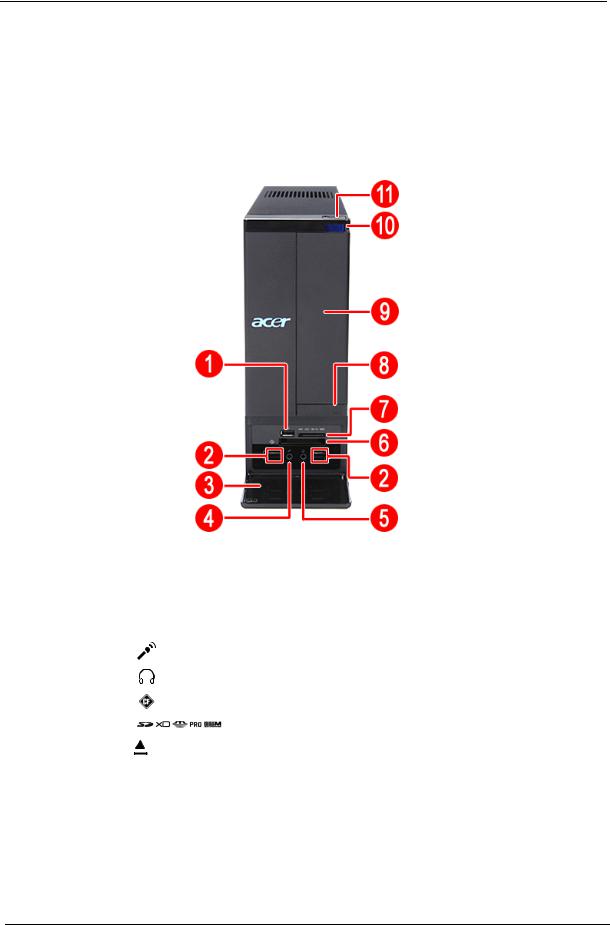
System Components
This section is a virtual tour of the system’s interior and exterior components.
Front Panel
X3400
No. |
Icon |
Component |
|
|
|
1 |
|
USB 2.0 ports |
|
|
|
2 |
|
|
|
|
|
|
|
|
3 |
|
Front I/O cover |
|
|
|
4 |
|
Microphone-in jack |
|
|
|
5 |
|
Headphone/Speaker-out/line-out jack |
|
|
|
6 |
|
CF I/II (CompactFlash Type I/II) slot |
|
|
|
7 |
|
Media card reader |
|
|
|
8 |
|
Drive bay door eject button |
|
|
Press to open drive bay door and access the optical drive. |
|
|
|
9 |
|
Optical drive bay door |
|
|
|
10 |
|
HDD activity indicator |
|
|
|
11 |
|
Power button/power indicator |
|
|
|
4 |
Chapter 1 |
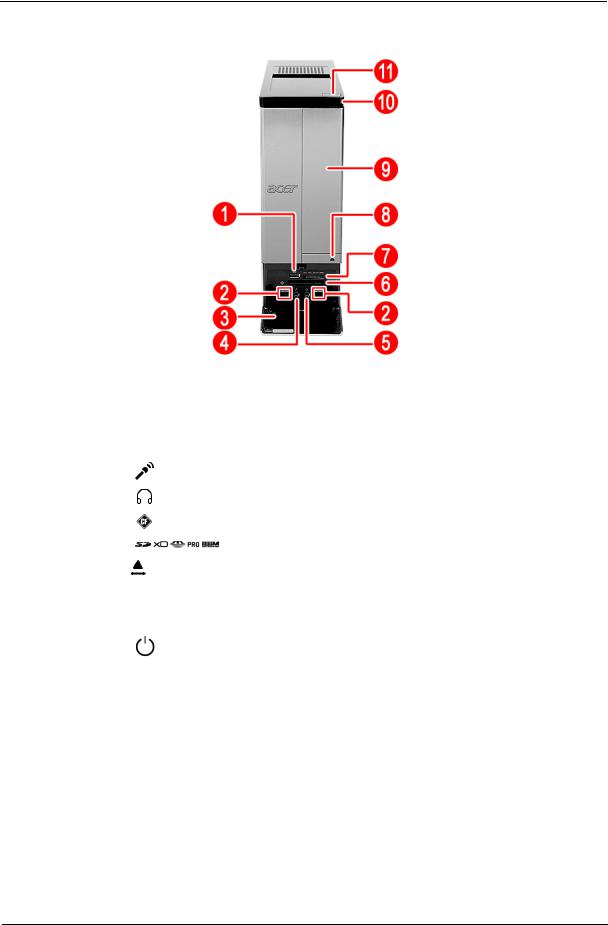
X5400
No. |
Icon |
Component |
|
|
|
1 |
|
USB 2.0 ports |
|
|
|
2 |
|
|
|
|
|
|
|
|
3 |
|
Front I/O cover |
|
|
|
4 |
|
Microphone-in jack |
|
|
|
5 |
|
Headphone/Speaker-out/line-out jack |
|
|
|
6 |
|
CF I/II (CompactFlash Type I/II) slot |
|
|
|
7 |
|
Media card reader |
|
|
|
8 |
|
Drive bay door eject button |
|
|
Press to open drive bay door and access the optical drive. |
|
|
|
9 |
|
Optical drive bay door |
|
|
|
10 |
|
HDD activity indicator |
|
|
|
11 |
|
Power button/power indicator |
|
|
|
Chapter 1 |
5 |
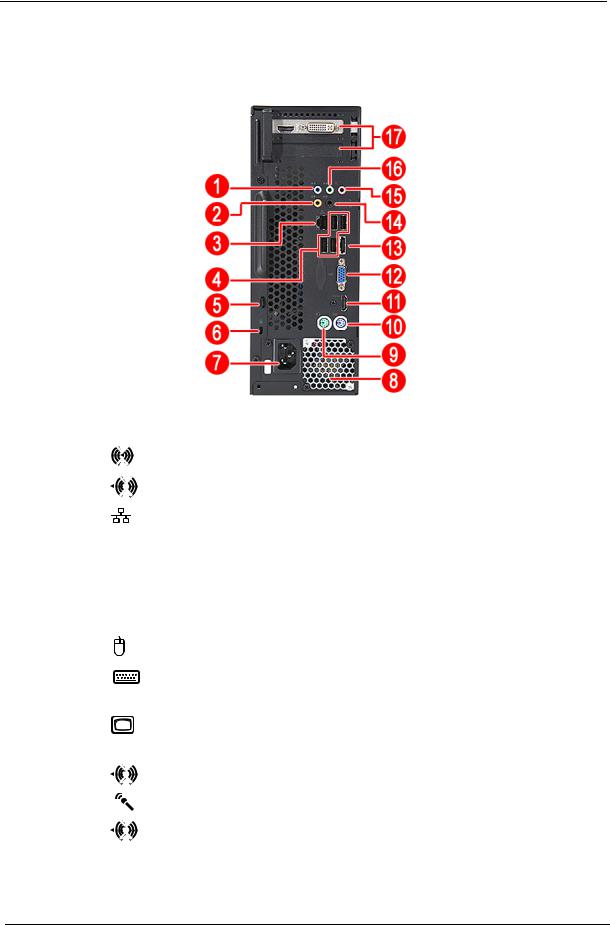
Rear Panel
X3400
No. |
Icon |
Component |
||||
|
|
|
|
|
|
|
1 |
|
|
|
|
|
Audio in or side speaker jack |
|
|
|
|
|
|
|
2 |
|
|
|
|
|
Center speaker/subwoofer jack |
|
|
|
|
|
|
|
3 |
|
|
|
|
|
Gigabit LAN port (10/100/1000 Mbps) |
|
|
|
|
|
|
|
4 |
|
|
|
|
|
USB 2.0 ports |
|
|
|
|
|
|
|
5 |
|
|
|
|
|
Key hole |
|
|
|
|
|
|
|
6 |
|
|
|
|
|
Lock slot |
|
|
|
|
|
|
|
7 |
|
|
|
|
|
Power connector |
|
|
|
|
|
|
|
8 |
|
|
|
|
|
Power supply (Photo shows PFC power supply) |
|
|
|
|
|
|
|
9 |
|
|
|
|
|
PS2 mouse port |
|
|
|
|
|
|
|
10 |
|
|
|
|
|
PS2 keyboard port |
|
|
|
|
|
|
|
11 |
|
|
|
|
|
HDMI port |
|
|
|
|
|
|
|
12 |
|
|
|
|
|
VGA monitor port |
|
|
|
|
|
|
|
13 |
|
|
|
|
|
eSATA port |
|
|
|
|
|
|
|
14 |
|
|
|
|
|
Rear speaker/surround out jack |
|
|
|
|
|
|
|
15 |
|
|
|
|
|
Microphone/speaker-out/line-in jack |
|
|
|
|
|
|
|
16 |
|
|
|
|
|
Line-out jack |
|
|
|
|
|
|
|
17 |
|
|
|
|
|
Expansion slot (Photo shows graphics card and TV tuner card) |
|
|
|
|
|
|
|
6 |
Chapter 1 |
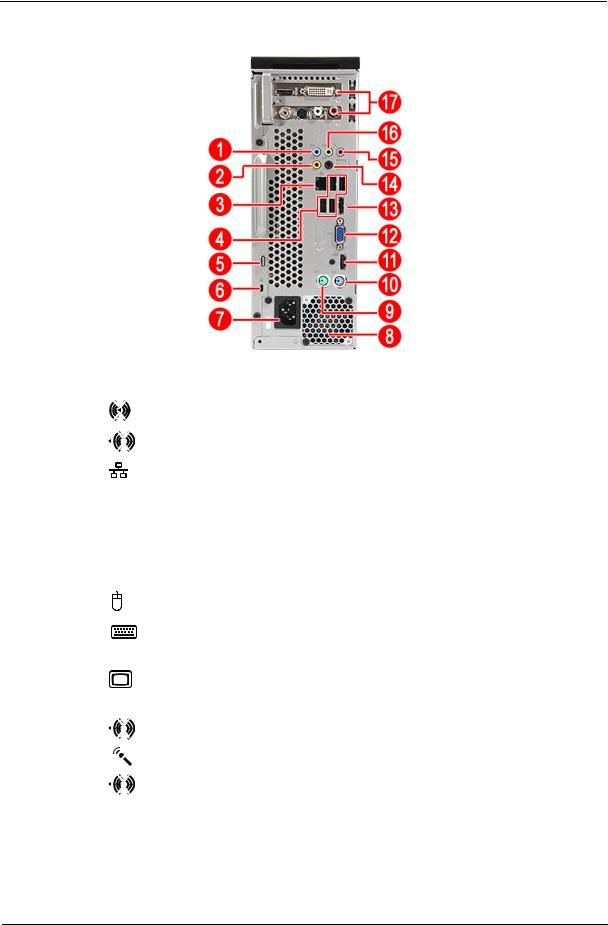
X5400
No. |
Icon |
Component |
||||
|
|
|
|
|
|
|
1 |
|
|
|
|
|
Audio in or side speaker jack |
|
|
|
|
|
|
|
2 |
|
|
|
|
|
Center speaker/subwoofer jack |
|
|
|
|
|
|
|
3 |
|
|
|
|
|
Gigabit LAN port (10/100/1000 Mbps) |
|
|
|
|
|
|
|
4 |
|
|
|
|
|
USB 2.0 ports |
|
|
|
|
|
|
|
5 |
|
|
|
|
|
Key hole |
|
|
|
|
|
|
|
6 |
|
|
|
|
|
Lock slot |
|
|
|
|
|
|
|
7 |
|
|
|
|
|
Power connector |
|
|
|
|
|
|
|
8 |
|
|
|
|
|
Power supply (Photo shows PFC power supply) |
|
|
|
|
|
|
|
9 |
|
|
|
|
|
PS2 mouse port |
|
|
|
|
|
|
|
10 |
|
|
|
|
|
PS2 keyboard port |
|
|
|
|
|
|
|
11 |
|
|
|
|
|
HDMI port |
|
|
|
|
|
|
|
12 |
|
|
|
|
|
VGA monitor port |
|
|
|
|
|
|
|
13 |
|
|
|
|
|
eSATA port |
|
|
|
|
|
|
|
14 |
|
|
|
|
|
Rear speaker/surround out jack |
|
|
|
|
|
|
|
15 |
|
|
|
|
|
Microphone/speaker-out/line-in jack |
|
|
|
|
|
|
|
16 |
|
|
|
|
|
Line-out jack |
|
|
|
|
|
|
|
17 |
|
|
|
|
|
Expansion slot (Photo shows graphics card and TV tuner card) |
|
|
|
|
|
|
|
Chapter 1 |
7 |
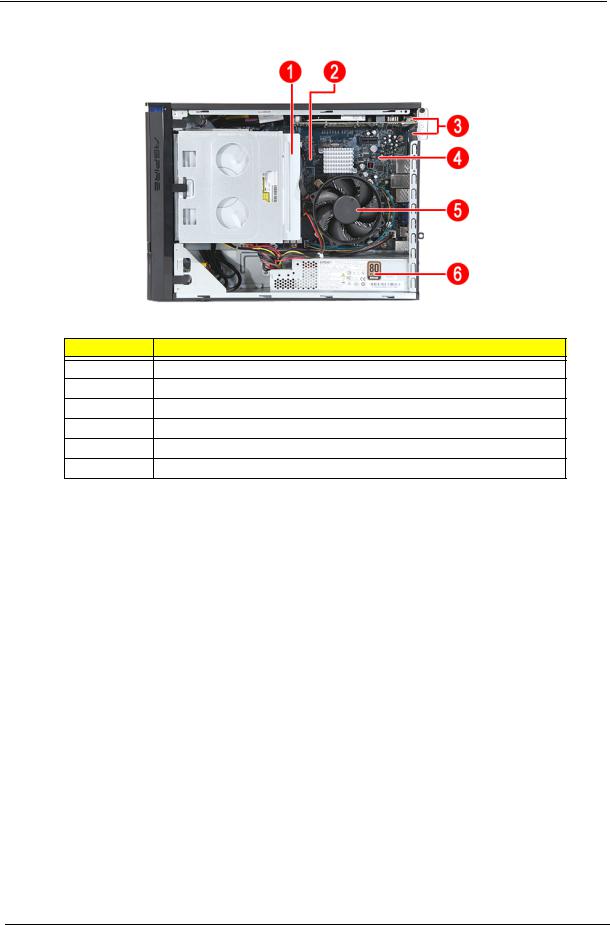
Internal Components
No. Component
1Optical drive
2Memory
3Expansion card
4Mainboard
5Heatsink fan assembly
6Power supply
8 |
Chapter 1 |

System LED Indicators
This section describes the different system LED indicators.
LED indicator |
Color |
LED status |
Description |
|
|
|
|
|
|
Power |
Blue |
On |
S0/S1 state |
|
|
|
|
|
|
|
Blue |
Blinking |
S3 state |
|
|
|
|
|
|
|
— |
Off |
S4/S5 state |
|
|
|
|
|
|
HDD activity |
Blue |
Blinking |
S0/S1 state |
|
|
|
|
|
|
LAN activity |
Blue |
Blinking |
S0/S1 state |
|
|
|
|
|
|
LAN port network |
Amber |
On |
1000 Mbps link network access |
|
speed LED (left) |
|
|
|
|
Green |
On |
100 Mbps link network access |
||
|
||||
|
|
|
|
|
|
— |
Off |
10 Mbps link network access |
|
|
|
|
|
|
LAN port network |
Green |
On |
Active network link |
|
connection LED |
|
|
|
|
|
Blinking |
Ongoing network data activity |
||
(right) |
|
|||
|
|
|
||
|
Off |
Off-line network |
||
|
|
|||
|
|
|
|
Chapter 1 |
9 |

10 |
Chapter 1 |

Chapter 2
System Utilities
CMOS Setup Utility
CMOS setup is a hardware configuration program built into the system ROM, called the complementary metaloxide semiconductor (CMOS) Setup Utility. Since most systems are already properly configured and optimized, there is no need to run this utility. You will need to run this utility under the following conditions.
When changing the system configuration settings
When redefining the communication ports to prevent any conflicts
When modifying the power management configuration
When changing the password or making other changes to the security setup
When a configuration error is detected by the system and you are prompted ("Run Setup" message) to make changes to the CMOS setup
NOTE: If you repeatedly receive Run Setup messages, the battery may be bad. In this case, the system cannot retain configuration values in CMOS. Ask a qualified technician for assistance.
CMOS setup loads the configuration values in a battery-backed nonvolatile memory called CMOS RAM. This memory area is not part of the system RAM which allows configuration data to be retained when power is turned off.
Before you run the CMOS Setup Utility, make sure that you have saved all open files. The system reboots immediately after you close the Setup.
NOTE: CMOS Setup Utility will be simply referred to as “BIOS”, "Setup", or "Setup utility" in this guide.
The screenshots used in this guide display default system values. These values may not be the same those found in your system.
Chapter 2 |
11 |

Entering CMOS setup
1.Turn on the computer and the monitor.
If the computer is already turned on, close all open applications, then restart the computer.
2.During POST, press Delete.
If you fail to press Delete before POST is completed, you will need to restart the computer.
The Setup Main menu will be displayed showing the Setup’s menu bar. Use the left and right arrow keys to move between selections on the menu bar.
Navigating Through the Setup Utility
Use the following keys to move around the Setup utility.
Left and Right arrow keys – Move between selections on the menu bar.
Up and Down arrow keys – Move the cursor to the field you want.
PgUp and PgDn keys – Move the cursor to the previous and next page of a multiple page menu.
Home – Move the cursor to the first page of a multiple page menu.
End – Move the cursor to the last page of a multiple page menu.
+ and - keys – Select a value for the currently selected field (only if it is user-configurable). Press these keys repeatedly to display each possible entry, or the Enter key to choose from a pop-up menu.
NOTE: Grayed-out fields are not user-configurable.
Enter key – Display a submenu screen. NOTE: Availability of submenu screen is indicated by a (>).
Esc – If you press this key:
On one of the primary menu screens, the Exit menu displays.
On a submenu screen, the previous screen displays.
When you are making selections from a pop-up menu, closes the pop-up without making a selection.
F1 – Display the General Help panel.
F9 – Press to load optimized default system values.
F10 – Save changes made the Setup and close the utility.
12 |
Chapter 2 |

Setup Utility Menus
CMOS Setup Utility - Copyright (C) 1985-2005, American Megatrends, Inc.
► Product Information |
► PC Health Status |
|
|
► Standard CMOS Features |
► Frequency/Voltage Control |
||
|
|
||
► Advanced BIOS Features |
► BIOS Security Features |
||
|
|
||
► Advanced Chipset Features |
Load Default Settings |
||
|
|
||
► Integrated Peripherals |
|
|
|
|
|
Save & Exit Setup |
|
► Power Management Setup |
|
|
|
|
|
Exit Without Saving |
|
:Move |
Enter:Select |
+/-/:Value |
ESC:Exit |
F1:General Help |
|
F9:Optimized Defaults |
F10:Save |
v02.66 |
(C)Copyright |
1985-2009, American Megatrends, |
Inc. |
The Setup Main menu includes the following main setup categories.
Product Information
Standard CMOS Features
Advanced BIOS Features
Advanced Chipset Features
Integrated Peripherals
Power Management Setup
PC Health Status
Frequency/Voltage Control
BIOS Security Features
Load Default Settings
Save & Exit Setup
Exit Without Saving
In the descriptive table following each of the menu screenshots, settings in boldface are the default and suggested settings.
Chapter 2 |
13 |

Product Information
The Product Information menu displays basic information about the system. These entries are for your reference only and are not user-configurable.
CMOS Setup Utility - Copyright (C) 1985-2005, American Megatrends, Inc.
|
Product Information |
|
Processor Type |
: |
Help Item |
AMD Phenom(TM) II X4 810 Processor |
|
|
Processor Speed |
:2.60GHz |
|
System Memory |
:1792MB |
|
System Manufacturer |
:xxxxxxxx |
|
Product Name |
:xxxxxxxx |
|
System Serial Number |
: |
|
System BIOS Version |
:P01-B0 |
|
BIOS Release Date |
:xxxxxxxxxx |
|
Asset Tag Number |
: |
|
|
:Move |
Enter:Select |
+/-/:Value |
ESC:Exit |
|
F1:General Help |
|
F9:Optimized Defaults |
F10:Save |
|
|
|
|
|
Parameter |
Description |
|
|
|
|
|
|
||
Processor Type |
Type of processor installed on the system. |
|
||
|
|
|
||
Processor Speed |
Speed of the processor installed on the system. |
|
||
|
|
|
||
System Memory |
Total size of system memory installed on the system. |
|
||
|
|
|
||
System Manufacturer |
Manufacturer of the system. |
|
||
|
|
|
||
Product Name |
Product name of the system. |
|
||
|
|
|
||
System Serial Number |
Serial number of the system. |
|
||
|
|
|
||
System BIOS Version |
Version number of the BIOS setup utility. |
|
||
|
|
|
||
BIOS Release Date |
Date when the BIOS setup utility was released |
|
||
|
|
|
||
Asset Tag Number |
Asset tag number of this system. |
|
||
|
|
|
|
|
14 |
Chapter 2 |

Standard CMOS Features
CMOS Setup Utility - Copyright (C) 1985-2005, American Megatrends, Inc.
Standard CMOS Features
System Date |
[Thu 04/02/2010] |
System Time |
[21:26:38] |
► AHCI Port 1 |
[Hard Disk] |
► AHCI Port 2 |
[Not Detected] |
► AHCI Port 3 |
[Not Detected] |
► AHCI Port 4 |
[Not Detected] |
Halt on |
[All, but keyboard] |
Help Item
Use [ENTER] , [TAB] or [SHIFT-TAB] to select a field.
Use [+] or [-] to configure system Date.
|
:Move |
Enter:Select |
+/-/:Value |
ESC:Exit |
|
|
F1:General Help |
|
F9:Optimized Defaults |
F10:Save |
|
|
|
|
|
|
|
Parameter |
Description |
|
|
|
Option |
|
|
|
|
||
System Date |
Set the date following the weekday-month-day-year format. |
|
|
||
|
|
|
|||
System Time |
Set the system time following the hour-minute-second format. |
|
|||
|
|
|
|
||
AHCI Port 1/2/3/4 |
Displays the status of auto detection of the AHCI device. |
|
|
||
|
|
|
|||
Halt On |
Determines whether the system will stop for an error during the POST. |
All, but keyboard |
|||
|
|
|
|
|
No Errors |
|
|
|
|
|
All Errors |
|
|
|
|
|
|
Chapter 2 |
15 |

Advanced BIOS Features
CMOS Setup Utility - Copyright (C) 1985-2005, American Megatrends, Inc.
Advanced BIOS Features
Quick Boot |
[Enabled] |
Quiet Boot |
[Disabled] |
1st Boot device |
[Hard Drive] |
2nd Boot device |
[CD/DVD] |
3rd Boot device |
[Removable Dev.] |
4th Boot device |
[Network] |
► Hard Disk Drive Priority |
[Press Enter] |
► Optical Disk Drive Priority |
[Press Enter] |
► Removable Device Priority |
[Press Enter] |
► Network Device Priority |
[Press Enter] |
Bootup Num-Lock |
[On] |
USB Beep Message |
[Disabled] |
Help Item
Allows BIOS to skip certain tests while booting. This will decrease the time needed to boot the system.
|
:Move |
Enter:Select |
+/-/:Value |
ESC:Exit |
|
|
F1:General Help |
|
F9:Optimized Defaults |
F10:Save |
|
|
|
|
|
|
|
Parameter |
Description |
|
|
|
Option |
|
|
|
|||
Quick Boot |
Allows you to decrease the time it takes to boot the computer by shortening |
Enabled |
|||
|
or skipping certain standard booting process. |
|
Disabled |
||
|
|
|
|||
Quiet Boot |
When enabled, the BIOS splash screen displays during startup. |
Enabled |
|||
|
When disabled, the diagnostic screen displays during startup. |
Disabled |
|||
|
|
|
|
||
1st/2nd/3rd/4th Boot Device |
Specifies the boot order from the available devices. |
|
Hard Disk |
||
|
|
|
|
|
CD/DVD |
|
|
|
|
|
Removable Dev. |
|
|
|
|
|
LAN |
|
|
|
|||
Hard Disk Drive Priority |
Press Enter to access the Hard Disk Drive Priority submenu and specify the boot device |
||||
|
priority sequence from available hard drives. |
|
|
||
|
|
||||
Optical Disk Drive Priority |
Press Enter to access the Optical Disk Drive Priority submenu and specify the boot device |
||||
|
priority sequence from available CD/DVD drives. |
|
|
||
|
|
||||
Removable Device Priority |
Press Enter to access the Removable Device Priority submenu and specify the boot device |
||||
|
priority sequence from available removable drives. |
|
|
||
|
|
||||
Network Device Priority |
Press Enter to access the Network Device Priority submenu and specify the boot sequence |
||||
|
from available network devices. |
|
|
||
|
|
|
|
||
Bootup Num-Lock |
Selects power on state for Num Lock. |
|
On |
||
|
|
|
|
|
Off |
|
|
|
|||
USB Beep Message |
Enables or disables BIOS to display error beeps or messages during USB |
Disabled |
|||
|
device enumeration. |
|
|
Enabled |
|
|
|
|
|
|
|
16 |
Chapter 2 |

Advanced Chipset Features
CMOS Setup Utility - Copyright (C) 1985-2005, American Megatrends, Inc.
Advanced Chipset Features
AMD Cool’n’Quiet |
[Enabled] |
AMD-V |
[Enabled] |
Memory Hole Remapping |
[Enabled] |
Hybrid SLI |
[Disabled] |
Primary Video |
[Auto] |
UMA Frame Buffer Size |
[Auto] |
Current UMA Size |
[256MB] |
Help Item
Options
Enable/disable the generation of ACPI_PPC, _PPS, and _PCT objects.
|
:Move |
Enter:Select |
+/-/:Value |
ESC:Exit |
|
|
F1:General Help |
|
F9:Optimized Defaults |
F10:Save |
|
|
|
|
|
|
|
Parameter |
Description |
|
|
|
Option |
|
|
|
|||
AMD Cool’n’Quiet |
Enables or disables the generation of ACPI_PPC, PPS, and PCT objects. |
Enabled |
|||
|
|
|
|
|
Disabled |
|
|
|
|||
AMD-V |
Enables or disables the AMD Virtualization Technology (VT) availability. |
Enabled |
|||
|
|
|
|
|
Disabled |
|
|
|
|||
Memory Hole Remapping |
Enables or disables remapping of overlapped PCI memory above the total |
Enabled |
|||
|
physical memory. |
|
|
Disabled |
|
|
|
|
|
||
Hybrid SLI |
Enables or disables the Hybrid SLI Technology. |
|
Enabled |
||
|
|
|
|
|
Disabled |
|
|
|
|
||
Primary Video |
Select a graphic controller as a primary boot device. |
|
Auto |
||
|
|
|
|
|
PCIE |
|
|
|
|
|
Onboard VGA |
|
|
|
|||
UMA Frame Buffer Size |
Select the amount of system memory used by the Intel graphics device. |
Auto |
|||
|
|
|
|
|
32 MB |
|
|
|
|
|
64 MB |
|
|
|
|
|
128 MB |
|
|
|
|
|
Disabled |
|
|
|
|
||
Current UMA Size |
Select a video memory size. |
|
256 MB |
||
|
|
|
|
|
128 MB |
|
|
|
|
|
Maximum |
|
|
|
|
|
|
Chapter 2 |
17 |

Integrated Peripherals
CMOS Setup Utility - Copyright (C) 1985-2005, American Megatrends, Inc.
|
Integrated |
Peripherals |
Onboard SATA Controller |
[Enabled] |
Help Item |
Onboard SATA Mode |
[AHCI] |
|
Onboard USB Controller |
[Enabled] |
Options |
Legacy USB Support |
[Enabled] |
|
USB Storage Emulation |
[Auto] |
Enabled |
Onboard Graphics Controller |
[Enabled] |
Disabled |
Onboard Audio Controller |
[Enabled] |
|
Onboard LAN Controller |
[Enabled] |
|
Onboard LAN Option ROM |
[Disabled] |
|
Onboard 1394 Controller |
[Enabled] |
|
|
:Move |
Enter:Select |
+/-/:Value |
ESC:Exit |
|
|
F1:General Help |
|
F9:Optimized Defaults |
F10:Save |
|
|
|
|
|
|
|
Parameter |
Description |
|
|
|
Option |
|
|
|
|
||
Onboard SATA Controller |
Enables or disables the onboard SATA controller. |
|
Enabled |
||
|
|
|
|
|
Disabled |
|
|
|
|
||
Onboard SATA Mode |
Select an operating mode for the onboard SATA. |
|
AHCI |
||
|
|
|
|
|
Native IDE |
|
|
|
|
||
Onboard USB Controller |
Enables or disables the onboard USB controller. |
|
Enabled |
||
|
|
|
|
|
Disabled |
|
|
|
|
||
Legacy USB Support |
Enables or disables support for legacy USB devices. |
|
Enabled |
||
|
|
|
|
|
Disabled |
|
|
|
|||
USB Storage Emulation |
When set to Auto, USB devices less than 2 GB will be emulated as |
Auto |
|||
|
Floppy and remaining as HDD. Forced HDD option can be used to |
Floppy |
|||
|
force a HDD formatted drive to boot as FDD. |
|
Hard Disk |
||
|
|
|
|
|
|
|
|
|
|
||
Onboard Graphics |
Enables or disables the onboard graphics controller. |
|
Enabled |
||
Controller |
|
|
|
|
Disabled |
|
|
|
|
||
Onboard Audio Controller |
Enabled or disables the onboard audio controller. |
|
Enabled |
||
|
|
|
|
|
Disabled |
|
|
|
|
||
Onboard LAN Controller |
Enables or disables the onboard LAN controller. |
|
Enabled |
||
|
|
|
|
|
Disabled |
|
|
|
|||
Onboard LAN Option ROM |
Enables or disables the load of embedded option ROM for onboard |
Enabled |
|||
|
network controller. |
|
|
Disabled |
|
|
|
|
|
||
Onboard 1394 Controller |
Enables or disables the onboard 1394 controller. |
|
Enabled |
||
|
|
|
|
|
Disabled |
|
|
|
|
|
|
18 |
Chapter 2 |

Power Management Setup
CMOS Setup Utility - Copyright (C) 1985-2005, American Megatrends, Inc.
Power Management Setup
ACPI Aware O/S |
[Yes] |
ACPI Suspend Mode |
[S3 (STR)] |
Power On by RTC Alarm |
[Disabled] |
Power On by PCIE Devices |
[Disabled] |
Power On by Onboard LAN |
[Disabled] |
Wake Up by PS/2 KB/Mouse |
[Enabled] |
Wake Up by USB KB/Mouse |
[Enabled] |
Restore On AC Power Loss |
[Last State] |
Help Item
Include ACPI APIC table pointer to RSDT pointer list.
|
:Move |
Enter:Select |
+/-/:Value |
ESC:Exit |
|
|
F1:General Help |
|
F9:Optimized Defaults |
F10:Save |
|
|
|
|
|
|
|
Parameter |
Description |
|
|
|
Option |
|
|
|
|||
ACPI Aware O/S |
Enables or disables the Advanced Configuration and Power |
Yes |
|||
|
Management (ACPI) function. |
|
Disabled |
||
|
|
|
|
|
|
ACPI Suspend Mode |
Select an ACPI state. |
|
|
S3 (STR) |
|
|
|
|
|
|
S1 (POS) |
|
|
|
|||
Power On by RTC Alarm |
Enables or disables real time clock (RTC) to generate a wake event. |
Enabled |
|||
|
|
|
|
|
Disabled |
|
|
|
|||
Power On by PCIE Devices |
Enables or disables to wake up the system from a power saving mode |
Enabled |
|||
|
through an event on PCI Express device. |
|
Disabled |
||
|
|
|
|||
Power On by Onboard LAN |
Enables or disables an onboard LAN controller to generate a wake |
Enabled |
|||
|
event. |
|
|
|
Disabled |
|
|
|
|||
Wake Up by PS/2 KB/Mouse |
Enables or disables to wake up the system from a power saving mode |
Enabled |
|||
|
using a PS2 keyboard or mouse. |
|
Disabled |
||
|
|
|
|||
Wake Up by USB KB/Mouse |
Enables or disables to wake up the system from a power saving mode |
Enabled |
|||
|
using a USB keyboard or mouse. |
|
Disabled |
||
|
|
|
|||
Restore On AC Power Loss |
Enables or disables the system to reboot after a power failure or |
Power Off |
|||
|
interrupt occurs. |
|
|
Power On |
|
|
|
|
|
|
Last State |
|
|
|
|
|
|
Chapter 2 |
19 |

PC Health Status
CMOS Setup Utility - Copyright (C) 1985-2005, American Megatrends, Inc.
PC Health Status
CPU Temperature |
:49oC/120oF |
System Temperature |
:38oC/100oF |
CPU Fan Speed |
:1021 RPM |
System Fan Speed |
:N/A |
CPU Core |
:1.312 V |
+1.1V |
:1.104 V |
+3.30V |
:3.360 V |
+5.00V |
:5.053 V |
+12.0V |
:11.904 V |
5VSB |
:5.134 V |
VBAT |
:3.136 V |
Smart Fan |
[Enabled] |
Help Item
Fan confiruration mode setting
|
:Move |
Enter:Select |
+/-/:Value |
ESC:Exit |
|
|
F1:General Help |
|
F9:Optimized Defaults |
F10:Save |
|
|
|
|
|
|
|
Parameter |
Description |
|
|
|
Option |
|
|
|
|||
Smart Fan |
Enables or disables the smart system fan control function. |
Enabled |
|||
|
|
|
|
|
Disabled |
|
|
|
|
|
|
20 |
Chapter 2 |

Frequency/Voltage Control
CMOS Setup Utility - Copyright (C) 1985-2005, American Megatrends, Inc.
Frequency/Voltage Control
Spread Spectrum |
[Enabled] |
Help Item |
Options
Disabled
Enabled
|
:Move |
Enter:Select |
+/-/:Value |
ESC:Exit |
|
|
F1:General Help |
|
F9:Optimized Defaults |
F10:Save |
|
|
|
|
|
|
|
Parameter |
Description |
|
|
|
Option |
|
|
|
|||
Spread Spectrum |
Enables or disables the reduction of the mainboard’s EMI. |
Enabled |
|||
|
Note: Remember to disable the Spread Spectrum feature if you are |
Disabled |
|||
|
overclocking. A slight jitter can introduce a temporary boost in clock |
|
|||
|
speed causing the overclocked processor to lock up. |
|
|
||
|
|
|
|
|
|
Chapter 2 |
21 |
